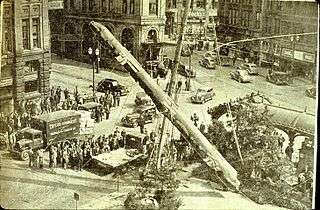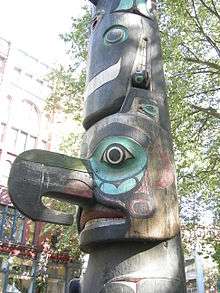Pioneer Square totem pole
The Pioneer Square totem pole, also referred to as the Seattle totem pole and historically as the Chief-of-All-Women pole, is a Tlingit totem pole located in Pioneer Square in downtown Seattle, Washington.
_(cropped).jpeg) The original totem pole, circa 1911 | |
| Location | Pioneer Square Seattle, Washington, U.S. |
|---|---|
| Type | Totem pole |
| Material | Hemlock (original) Red cedar (replica) |
| Width | 4.5 feet (1.4 m) (replica)[1] |
| Height | 49 feet 8 inches (15.14 m) (original) 50 feet (15 m) (replica) |
| Completion date | c. 1790 (original) 1940 (replica) |
 | |
| Coordinates | 47°36′7.5″N 122°20′2.6″W |
| Part of | Pioneer Square–Skid Road District (ID70000086) |
| NRHP reference No. | 77001340 |
| Significant dates | |
| Added to NRHP | May 5, 1977 |
| Designated NHL | May 5, 1977 |
| Designated CP | June 22, 1970 |
The original totem pole was carved in 1790 and raised in the Tlingit village on Tongass Island, Alaska to honor the Tlingit woman Chief-of-All-Women. The totem pole was later stolen by Seattle businessmen on an expedition to Alaska and subsequently gifted to the City of Seattle in 1899, where it was raised in Pioneer Square and became a source of civic pride. The totem pole was later damaged by arson and a replica was commissioned and installed in its place in 1940, which is now designated a National Historic Landmark.
History
Tlingit origin
The totem pole was initially carved around the year 1790 and belonged to the Kinninook family, a Tlingit clan of the Raven moiety.[2] It was carved to honor Chief-of-All-Women, a Tlingit woman who drowned in the Nass River while traveling to visit an ill sister.[3][2] Her family hired a carver and gathered to tell him stories they wanted represented on her totem pole.[2] When the totem pole was complete, they organized a potlatch and raised the totem pole in her honor[2] in the Tlingit village on Tongass Island.[4] It was one of the few totem poles dedicated to a woman.[2]
Seattle Post-Intelligencer expedition
In 1899, the Seattle Post-Intelligencer sponsored an expedition of "leading Seattle citizens"[3] to the District of Alaska.[5] The expedition was meant to be a "goodwill tour," with a mixture of business and pleasure,[5] and the goal of investigating increased trade and investment in Alaska.[4] However, even as the Klondike Gold Rush came to an end, civic leaders also wanted to solidify Seattle as the "Gateway to Alaska"[6] and the Seattle Chamber of Commerce included a committee of prominent businessmen on the expedition.[5]
On August 17, 1899, the expedition set sail on the steamship City of Seattle[3] with a total of 165 men and women.[5] The expedition included stops at Vancouver, Mary Island, New Metlakahtla, Ketckikan, Wrangel, Juneau, the Treadwell Mines, Skagway, Lake Bennett, Dyea, Pyramid Harbor, Glacier Bay, Muir Glacier, Killisnoo, Sitka and Victoria.[5]
On the morning of August 28, 1899,[7] the City of Seattle stopped at the Tlingit village at Fort Tongass[4] when members of the Chamber of Commerce committee spotted multiple totem poles.[2] The village appeared to be deserted and they decided to take a totem pole as a souvenir.[2] Third mate R. D. McGillvery and other members of the expedition went ashore and McGillvery later described the events as:
The Indians were all away fishing, except for one who stayed in his house and looked scared to death. We picked out the best looking totem pole... I took a couple of sailors ashore and we chopped it down—just like you'd chop down a tree. It was too big to roll down the beach, so we sawed it in two.[3]
During the process, McGillvery and the other sailors broke the beak on the bottom figure which was later incorrectly reconstructed.[2] A carving of a seal, about 8 feet (2.4 m) in length, was also taken from the Tlingit village.[8] After the totem pole was floated back to the ship, the Chamber of Commerce committee collectively paid McGillvery $2.50 for his labor.[3] The expedition returned to Seattle on August 30, 1899, and the Chamber of Commerce committee subsequently presented the totem pole to the Seattle City Council as a gift to the city.[6]
Installation in Pioneer Square

The totem pole was repaired, repainted, and stored at the Denny Hotel in Denny Hill under watch of three members of the Chamber of Commerce committee. On October 18, 1899, the totem pole was raised in Pioneer Square in downtown Seattle[6][9] and was "greeted by cheers of a multitude of people."[3] At the ceremony, city officials praised the Chamber of Commerce committee for their gift and assured the gathered crowd that no one had owned the totem pole and that the expedition saved it from its certain destruction.[9]
The Tlingit however, with the exception of the elderly and small children,[2] had simply been away for the fishing and cannery season when the City of Seattle arrived at Fort Tongass[6] and they were shocked to discover the totem pole gone when they returned. David E. Kinninook, who was a descendant of Chief-of-All-Women, and Tlingit witnesses of the theft contacted the governor of the District of Alaska John Green Brady and demanded legal action and $20,000 for the totem pole.[10] The Kinninook family also sent a delegation to Seattle in an unsuccessful attempt to retrieve the totem pole.[11]
The demand for legal action led to a federal grand jury in Alaska indicting eight men on the Chamber of Commerce committee for theft of government property.[lower-alpha 1][3] Attorney William H. Thompson, who was also on the expedition,[5] defended the indicted men and stated that:
The village has long since been deserted ... Here the totem will voice the natives' deeds with surer speech than if lying prone on moss and fern on the shore of Tongass Island.[3]
The suit was dismissed after a U.S. District Court Judge stopped in Seattle on the way to his new Alaska posting and was entertained at the private Rainier Club.[3] The City of Seattle was allowed to keep the totem pole and the Chamber of Commerce committee was charged a nominal fine of $500,[12] which the Seattle Post-Intelligencer paid on their behalf.[3]
In the interim, the totem pole had become a source of civic pride for Seattle[13][14] and was featured on post cards and brochures. In 1909, Seattle hosted the Alaska–Yukon–Pacific Exposition, which in part celebrated the transformation of Seattle from a small town to a booming city, and the totem pole was featured on the official brochure.[14] The totem pole had lost all association with the Tlingit owners[14] and a 1910 article described it as the "totem pole that made Seattle famous."[15]
Destruction and commission of replica

In October 1938, the totem pole was damaged by an arsonist[12] and was found to be too damaged by dry rot for repair; the Seattle City Council and Park Board sought to have a replica commissioned.[16] The United States Forest Service was directing a totem pole restoration project in southeastern Alaska and offered to employ Civilian Conservation Corps Tlingit carvers to craft a replica.[17][16]
The damaged totem pole was shipped to Saxman, Alaska, where Tlingit carver Charles Brown directed a team of carvers which included members of the Kinninook family.[17][18] The replica was completed after three months of work, and because the red cedar used to carve the totem pole had come from Forest Service land and the carvers were paid by the government, a special act of Congress was passed to allow transfer of ownership of the totem pole from the Forest Service to the City of Seattle.[19] The completed replica was dedicated with tribal blessings[12] and shipped to Seattle in April 1940 and then raised in Pioneer Square in a ceremony on July 24, 1940.[17]
In 1972, Tsimshian carver John C. Hudson, Jr. restored and repainted the totem pole.[15] In 1977, the totem pole—along with the Pioneer Building and pergola in Pioneer Square—was designated a National Historic Landmark.[12]
Appearance and meaning

The original Chief-of-All-Women pole was 49 feet 8 inches (15.14 m) tall[7] and was carved from hemlock,[18] while the replica stands 50 feet (15 m) tall and was carved from a 70-foot (21 m) red cedar from Kina Cove near Kasaan, Alaska.[18]
The original totem pole had been repainted with successive coats of non-Tlingit colors in an attempt to preserve the pole.[20] The replica, however, used the native Tlingit colors of black, red and blue-green.[20]
Totem poles are read from top to bottom, with the topmost figure identifying the owner.[21] On the Pioneer Square totem pole that is Raven, which in Tlingit mythology "did everything, knew everything, and seemed to be everywhere at once."[3] The other figures, in descending order on the totem pole, are: a woman holding her frog child, the woman's frog husband, Mink, Raven and Whale with a seal in his mouth.[21] At the bottom of the totem pole is Raven-at-the-Head-of-Nass, who is also called Grandfather of Raven.[15][21]
Three legends told by Chief-of-All-Women's lineage are represented on the totem pole. The first legend is Raven Steals the Sun, Stars and Moon, which involves Raven, who holds the crescent moon in his beak, and Grandfather of Raven.[21] In this legend, Raven, who had made all living creatures, lived in darkness because he had not yet made the sun. One day, he learned that there was a chief who possessed the sun, the moon, and the stars in a box. Raven turned himself into a needle and fell into the chief's daughter's drinking cup, who drank the needle and gave birth to a son, who was Raven. The chief (Grandfather of Raven) loved his grandson (Raven) and gave him whatever he asked for, including the moon and stars, which Raven scattered across the sky. Grandfather of Raven then gave Raven the box containing the sun, which Raven took and flew up through the smoke hole with. He then opened the box and let sunlight into the world, which frightened and subsequently spread his people to every corner of the world.[22][23]
The second legend concerns the woman holding her frog child and the woman's frog husband. In it, a young woman makes a derogatory remark about frogs which a frog hears before turning himself into a man. The woman then married him and was happy until she learned that they lived under a lake and her husband and his relatives and her own children were all frogs. She sent her children to her father's home, who sent the frogs away, but he eventually became suspicious and discovered his daughter living in the lake with the frogs. He drained the lake, killing his daughter's frog husband, but rescuing his daughter and grandchildren. She did not live long afterwards though and her frog children eventually turned into humans and never returned to the lake.[23][24]
The final legend involves Raven and Mink, who are swallowed by a whale along with firewood and stones they bring to build a fire in his stomach. When the whale swallows fish, Raven and Mink cook them over the fire. However, the whale does not swallow enough fish and they begin to cut slices of fat from the whale's stomach. Eventually, they grow tired of their journey and cut out the whale's heart and kill him. The whale washes ashore and Raven sings until people come and cut open the whale to free Raven and Mink. Raven emerges sleek and glossy, while Mink emerges a dirty brown color from drying himself in rotten wood. Raven consumes all the meat and oil of the whale himself before setting off on further adventures.[23][25]
Modern-day controversy
The Coast Salish, who are native to Seattle and the Pacific Northwest Coast, did not traditionally carve totem poles and the Pioneer Square totem pole was the first totem pole in Seattle.[26] Totem poles have since become a symbol of Seattle and are used in tourism campaigns, while native Salish art has not been featured as prominently.[27] Seattle City Councilmember Debora Juarez, a member of the Blackfeet Nation, called for a review of all the totem poles in the city for cultural sensitivity, which was granted by the city council in November 2018.[27]
References
Notes
- The Tlingit village was located at Fort Tongass, a United States Army base
Citations
- Childress 2013.
- Garfield 1996, p. 9.
- Wilma 2000.
- Jonaitis 2017, p. 3.
- The Business Men's Excursion Departs 1899.
- Wright 2015.
- New Emblem for Seattle 1899.
- Alaska Totem Pole 1899.
- Jonaitis 2017, p. 4.
- Jonaitis 2017, pp. 4–5.
- Kramer 2012.
- National Park Service.
- Sundquist 2010, p. 11.
- Jonaitis 2017, p. 5.
- Seattle Department of Neighborhoods.
- Garfield 1996, p. 12.
- Jonaitis 2017, p. 6.
- Garfield 1996, p. 13.
- Garfield 1996, pp. 15–16.
- Garfield 1996, p. 15.
- Garfield 1996, p. 17.
- Garfield 1996, p. 23.
- Sherwood 1975.
- Garfield 1996, p. 29-30.
- Garfield 1996, p. 26-27.
- Sundquist 2010, p. 12.
- Sullivan 2018.
Sources
- "Alaska Totem Pole Brought From Port Tongass by the P.-I. Excursion to be Set Up in Pioneer Square". Seattle Post-Intelligencer. September 3, 1899. p. 18. Retrieved January 11, 2019 – via Newspapers.com.
- Childress, Tamara (April 4, 2013). "Weekly Art Hit: 'Seattle Totem Pole'". artbeat.seattle.gov. Retrieved January 8, 2019.CS1 maint: ref=harv (link)
- Garfield, Viola E. (1996). Seattle's Totem Poles. Thistle Press. ISBN 978-0-9621935-4-5.CS1 maint: ref=harv (link)
- Jonaitis, Aldona (2017). Discovering Totem Poles: A Traveler's Guide. University of Washington Press. ISBN 9780295806884.CS1 maint: ref=harv (link)
- Kramer, Pat (2012). Alaska's Totem Poles. Graphic Arts Books. ISBN 9780882409016.CS1 maint: ref=harv (link)
- Moore, Emily L. (2018). Proud Raven, Panting Wolf: Carving Alaska's New Deal Totem Parks. University of Washington Press. ISBN 9780295743943.CS1 maint: ref=harv (link)
- National Park Service. "Iron Pergola and Totem Pole". National Park Service. Retrieved June 7, 2019.CS1 maint: ref=harv (link)
- "New Emblem for Seattle". Seattle Post-Intelligencer. August 31, 1899. p. 7. Retrieved January 11, 2019 – via Newspapers.com.
- Sundquist, Mark (2010). Seattle. Arcadia Publishing. ISBN 9780738580081.CS1 maint: ref=harv (link)
- Seattle Department of Neighborhoods. "Seattle Historical Sites Search Result – Department of Neighborhoods (DON)". web6.seattle.gov. Retrieved January 10, 2019.
- Sherwood, Donald N. (1975). "History: Pioneer & Occidental Squares" (PDF). Sherwood Park History Files. Seattle Municipal Archives. Retrieved January 8, 2019.CS1 maint: ref=harv (link)
- Sullivan, Jennifer (November 7, 2018). "Seattle to take closer look at public art to make sure it's culturally appropriate". KOMO. Retrieved January 13, 2019.CS1 maint: ref=harv (link)
- "The Business Men's Excursion Departs: Post-Intelligencer Alaska Expedition En Voyage to the Famous Northland". Seattle Post-Intelligencer. August 18, 1899. p. 1. Retrieved January 8, 2019 – via Newspapers.com.
- Wilma, David (January 1, 2000). "Stolen totem pole unveiled in Seattle". HistoryLink. Retrieved January 8, 2019.CS1 maint: ref=harv (link)
- Wright, Robin K. (November 19, 2015). "How did totem poles become a symbol of Seattle?". Burke Museum of Natural History and Culture. Retrieved January 8, 2019.CS1 maint: ref=harv (link)